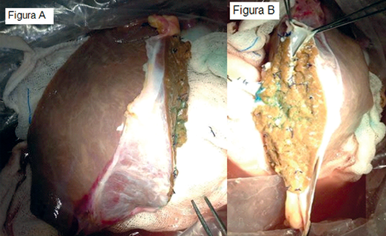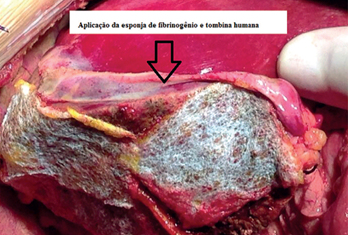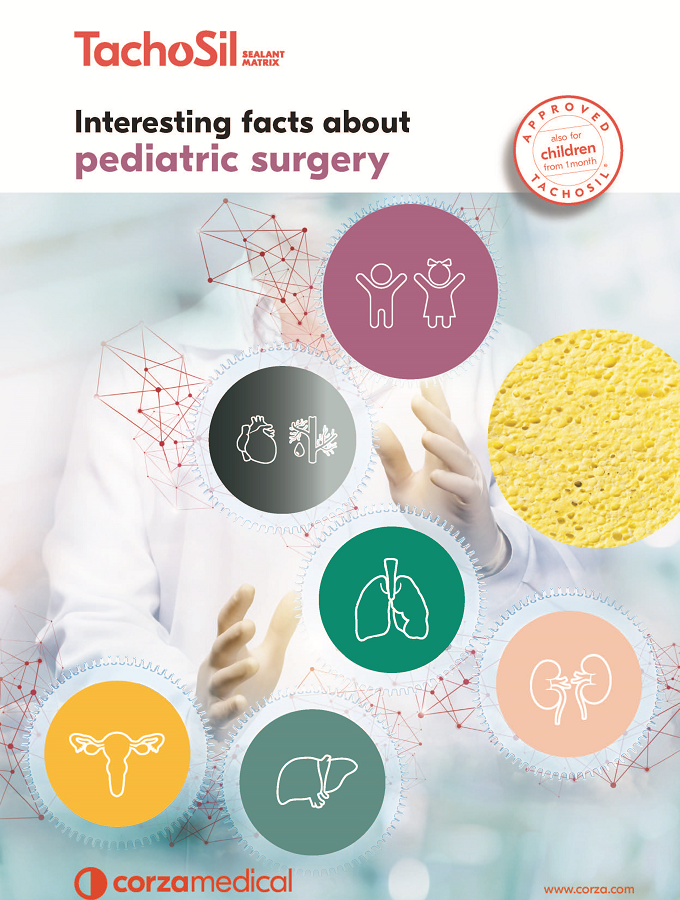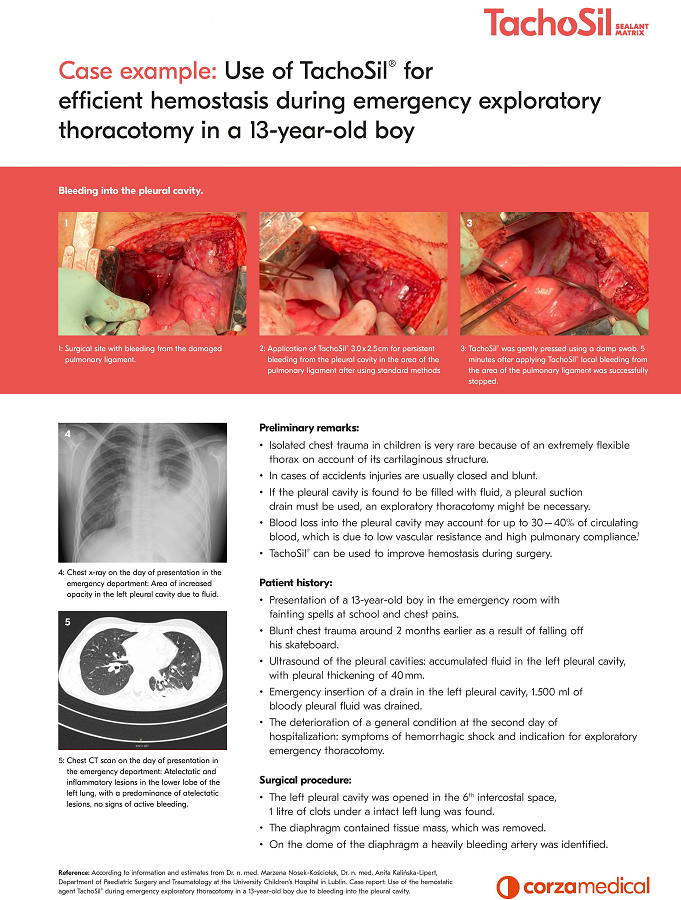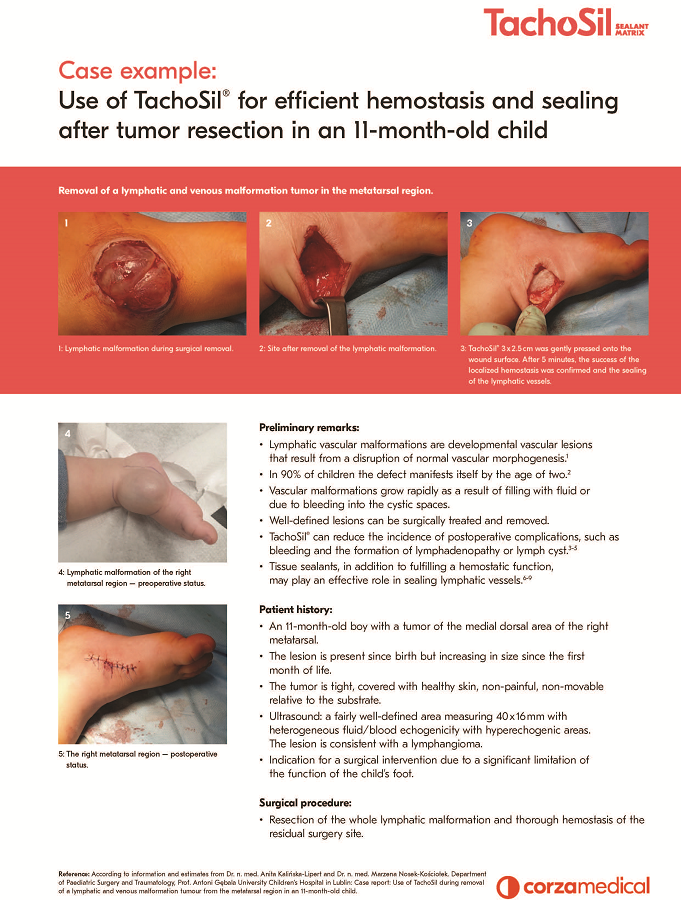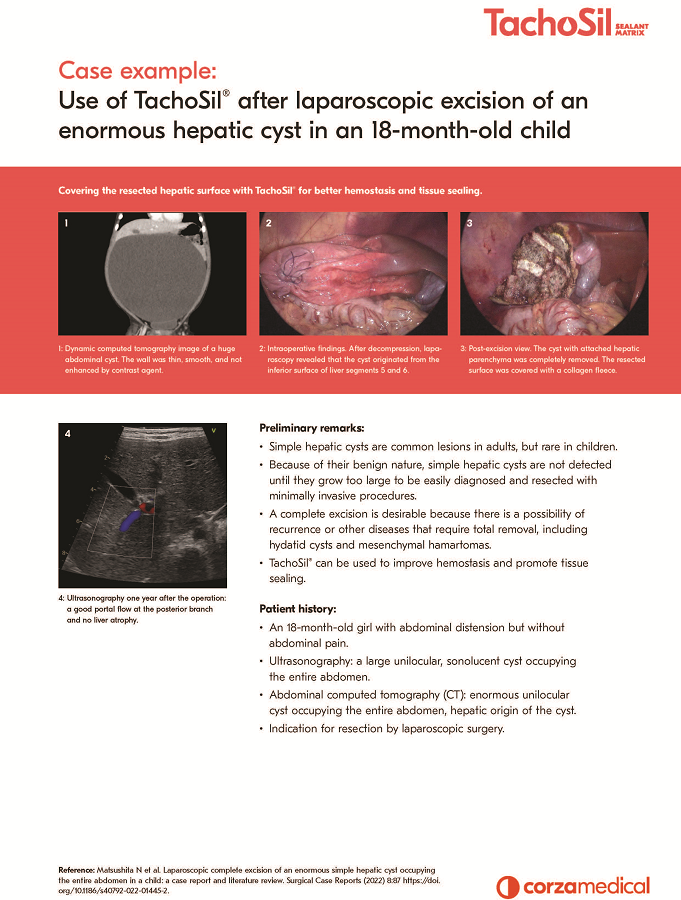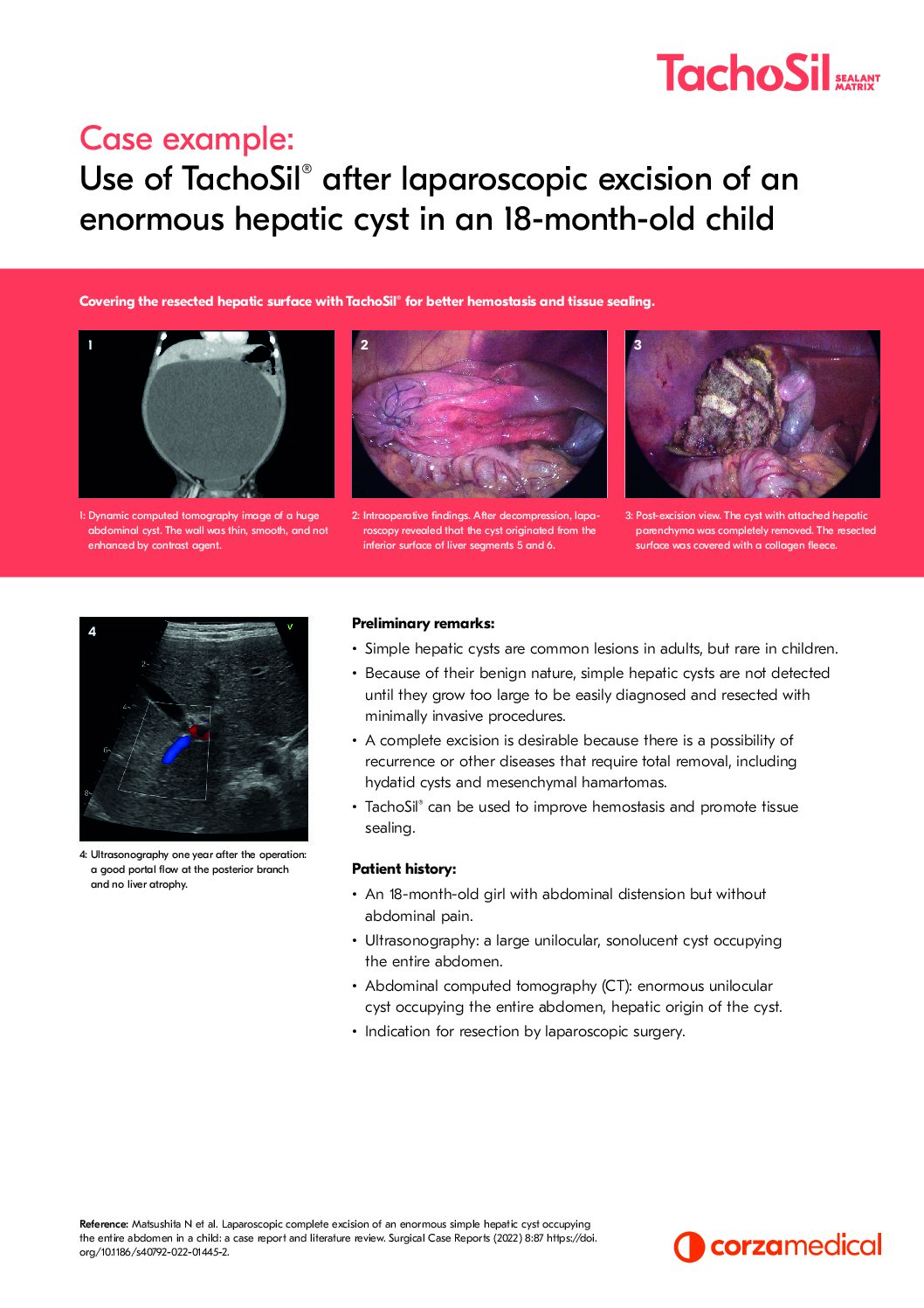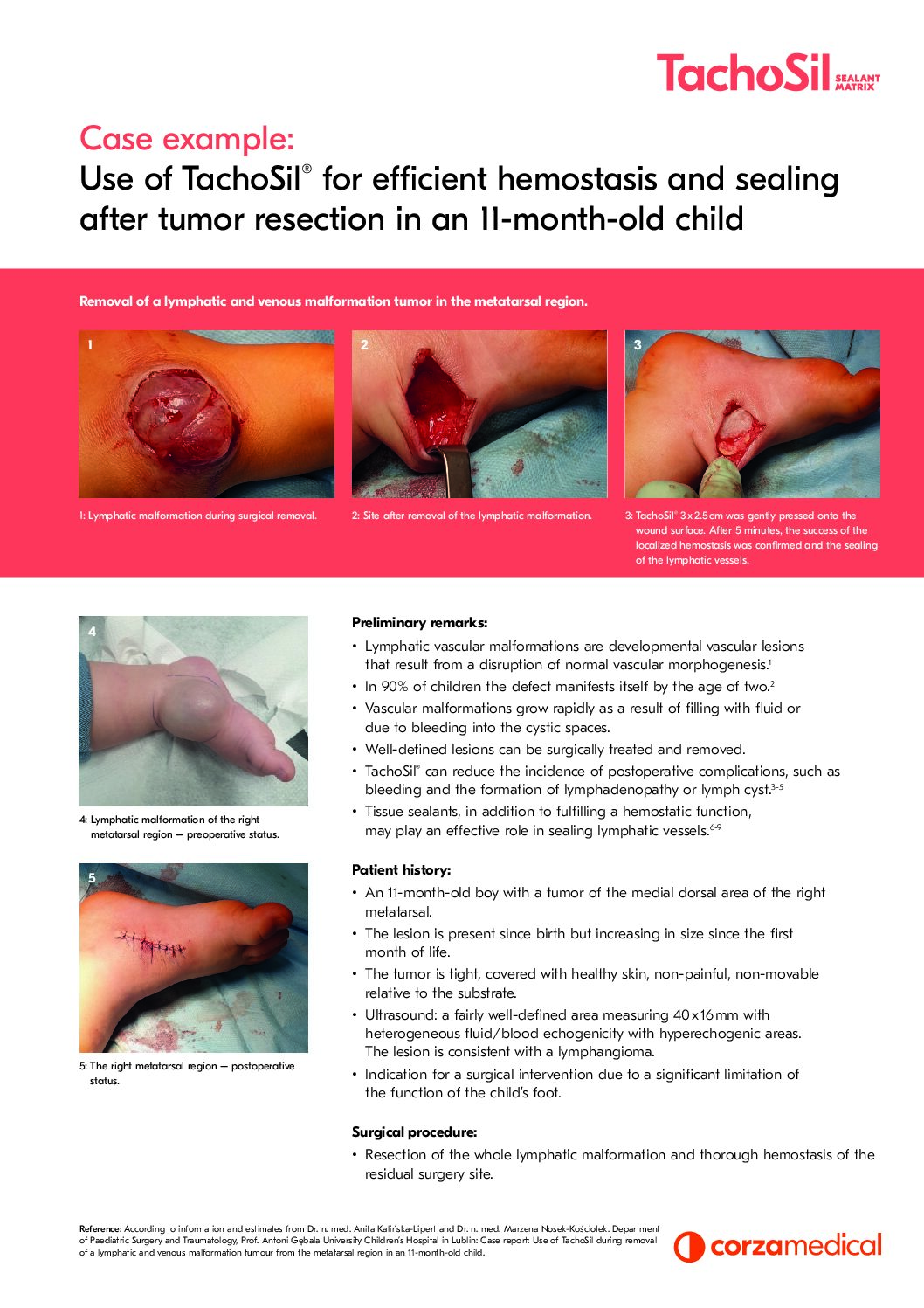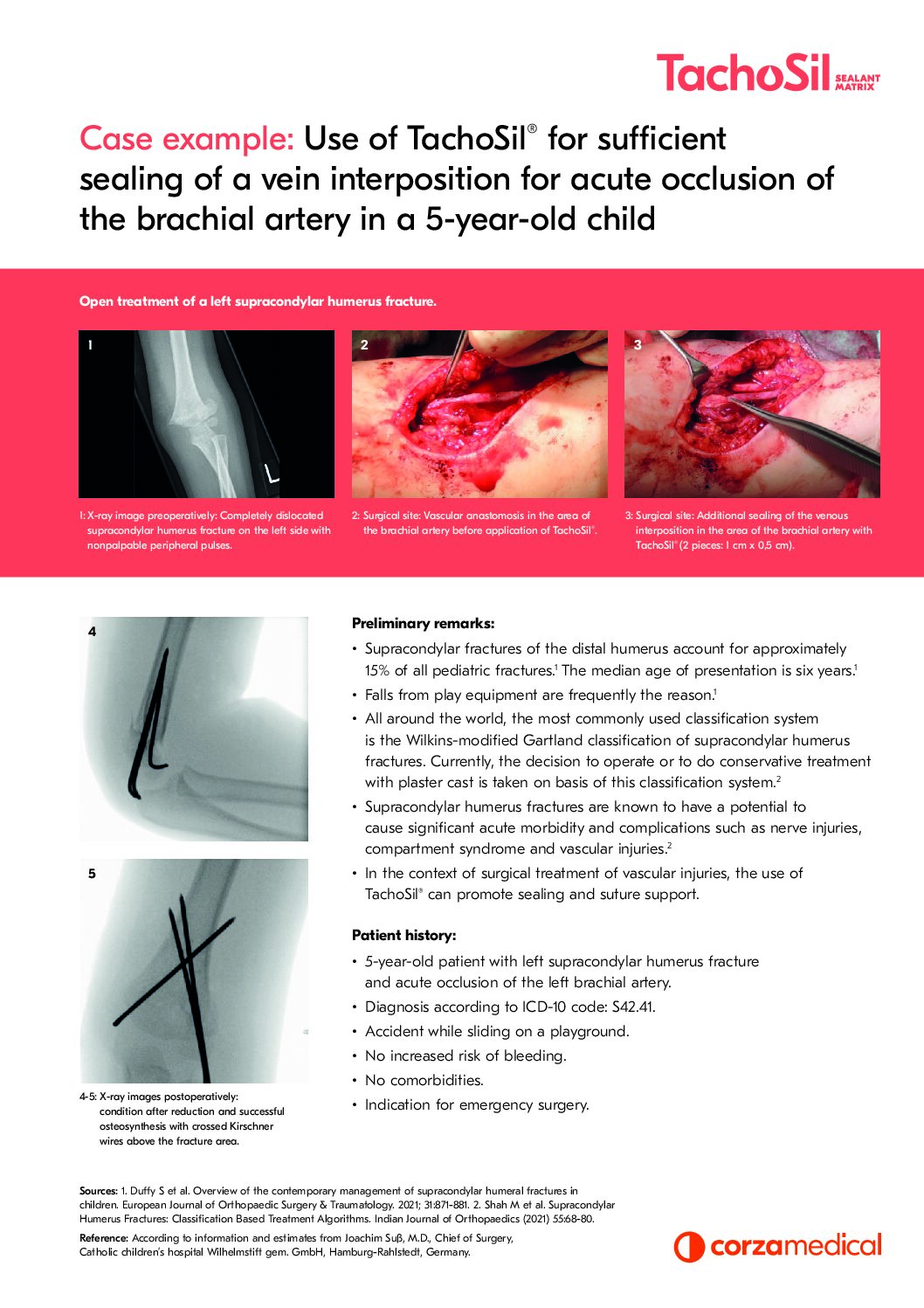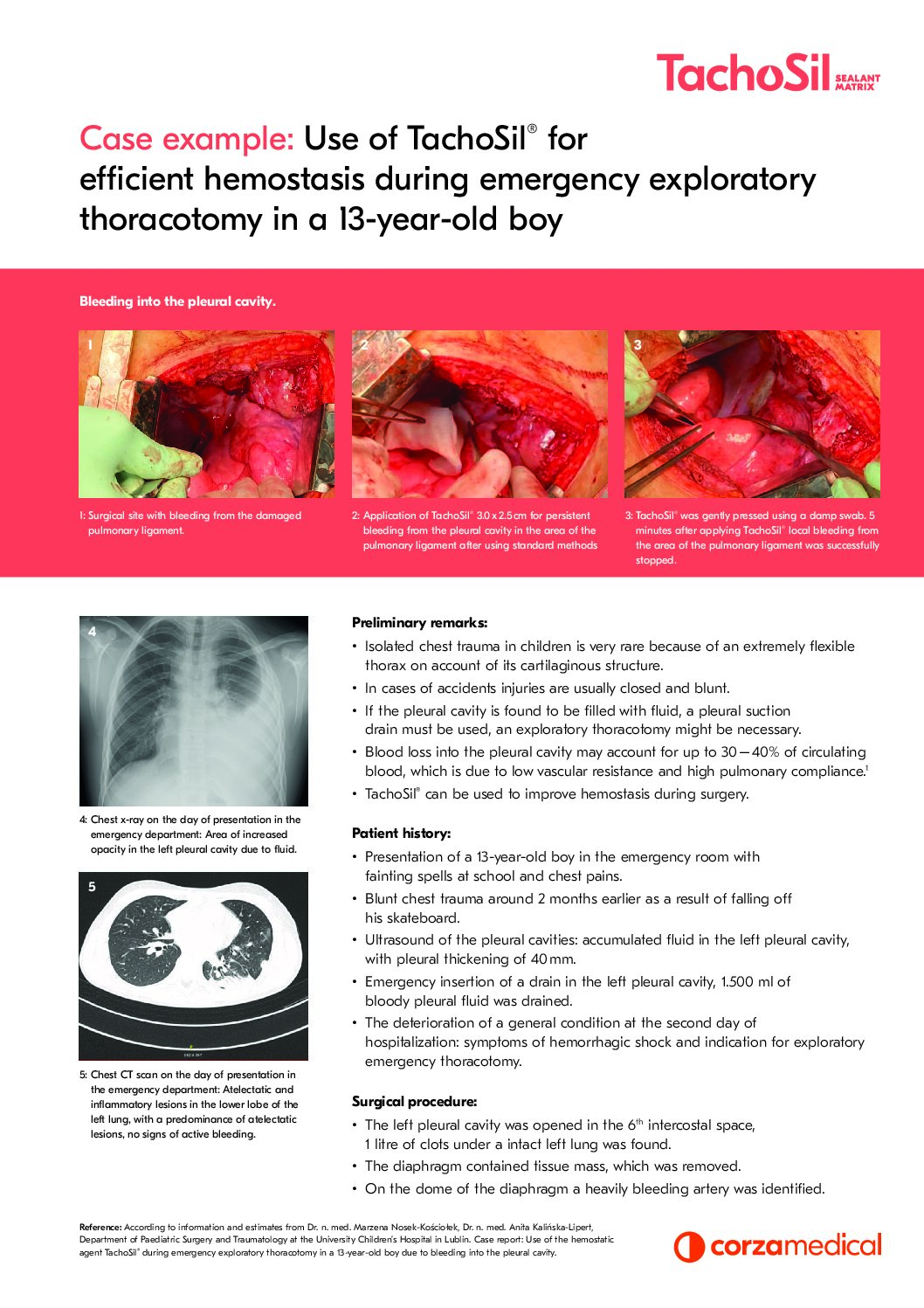
A Flexible Hemostasis & Sealing Solution
In pediatric surgery, the broad spectrum of indications from multiple specialties presents a challenge to all pediatricians seeking for aids to achieve safe hemostasis and sealing.
As your pediatric patients are not small adults, their metabolism, growth, physical and mental development are special and so need special treatment. A customized care makes a very big difference and initiated Corza Medical to evaluate the registration of our hemostasis and sealing solution to very defined indications for this group of patients.
As the majority of surgical solutions are dedicated to adult patients, the most recent 2023 EMA approval of our hemostasis and sealing solution for pediatric patients greater than 1 month of age* has the potential to augment your portfolio of solutions to fight hemorrhage and leakages.
TachoSil® is a ready-to-use fixed combination of collagen patch and active coagulation factors to improve hemostasis.
Moreover, sealing capabilities to provide suture support in vascular surgery and prevention of body liquid as well as air leakages are highly demanded. Liquid tight suture hole sealing on top of accelerating the hemostatic cascade are values of TachoSil® as a dual-action-patch in a range of pediatric indications demonstrated by evidence based medicine.
Want to read more? Click here to register (via DocCheck).
Need additional information? Click here to contact Corza directly.

The Benefits of Corza Medical’s Hemostasis & Sealing Solution in Pediatric Surgery
- Very good tolerance
- Extremely high operational safety and reliability
- Very quick to use
- Immediate success of the application recognizable
- Avoidance/reduction of operational risks
- Reduction of operating times
- Reduction of transfusion risk
- Increased safety for patients
Most important surgical procedures and areas of application in pediatric surgery
Applications in Pediatric Cardiovascular Surgery:
- Botall’s artery ductus patent – PDA
- Aortic coarctation
- septal defect – ASD
- Transposition of great arterial trunks – TGA
- Left heart hypoplasia syndrome – HLHS
- Tetralogy of Fallot – TOF
- Common atrioventricular canal – CAVC
- Common artery trunk – TAC
- Congenital obstruction of the gastrointestinal tract (i.e. congenital obstruction of the esophagus, of the small and large intestine)
- Appendicitis
- Hernia
- Meckel diverticle
- Esophagus: atresia with/without fistula
- Intestinal atresia
- Pancreatic tail resections
- Lung malformations (congenital)
- Distance sequester
- Partial removal of lung tissue
- Diaphragmatic defects
- Chest malformations (funnel chest)
- Nuss-procedure
- Pectus excavatus
- Inflammation (lung abscesses, pleural rind)
- Endoscopic and open thoracotomy procedures (VATS)
- Thoracic injuries
- Sealing pulmonary leakages
- Bladder extrophy
- Testicular torsion
- Ovarian torsion
- Cervical fistula
- Phimosis
- Operation of urethral valves
- Correction of penile malformations
- Bony fractures of extremities, rib cage, pelvis, spine, skull, etc.
- Special spina bifida and hydrocephalus surgery
- Pediatric plastic surgery with burn medicine
- Cuts, lacerations, traffic accidents
- Esophagus: atresia with/without fistula
- Intestinal atresia
- Idiopathic scoliosis
- Gut – duplicate
- Diaphragmatic atresia
- Biliary atresia
- Bladder extrophy
- Anal atresia
- Hirschsprung disease
- Neuroblastoma
- Hepatoblastoma
- Nephroblastoma (Wilms’ tumors)
- Soft tissue sarcomas
- Ovarian tumors
- Tumors pancreas
- Thyroid cancer
- Liver transplantation
- Kidney transplantation
- Multiorgan transplantation (kidney, liver, intestine)
Want to read more? Click here to register (via DocCheck).
Need additional information? Click here to contact Corza directly.
Pediatric Case Reports & Resources
Want to read more? Click here to register (via DocCheck).
Need additional information? Click here to contact Corza directly.
Corza hemostasis and sealing solution in pediatric surgery
Clinical publications and further literature
- Corrective surgery using a gridiron incision for abdominal pain caused by a folded ovary in the third trimester of pregnancy. Kim AM, Kim JW, Kim YH, Kim TY, Ryu HK, Choi MG. J Int Med Res. 2021 Mar;49(3):300060521997743. doi: 10.1177/0300060521997743. PMID: 33729868
- Plaque incision and Tachosil graft in Peyronie’s Disease. de Sallmard G, Morel-Journel N, Sbizzera M, Hanquiez P, Ruffion A, Terrier JE. Prog Urol. 2020 Feb;30(2):119-125. doi: 10.1016/j.purol.2019.11.011. Epub 2020 Feb 14. PMID: 32067908
- Liquorrhea after removal of fourth ventricle tumors in children. Retrospective analysis of a series of 211 primary surgeries. Kushel’ YV, Danilov GV, Tekoev AR, Chel’diev BZ, Strunina YV. Zh Vopr Neirokhir Im N N Burdenko. 2018;82(5):39-47. doi: 10.17116/neiro20188205139. PMID: 30412155
- Cisterna magna arachnoid membrane suturing decreases incidence of pseudomeningocele formation and incisional CSF leakage. Pitskhelauri D, Kudieva E, Moshchev D, Ananev E, Shifrin M, Danilov G, Melnikova-Pitskhelauri T, Kachkov I, Bykanov A, Sanikidze A. Acta Neurochir (Wien). 2018 May;160(5):1079-1087. doi: 10.1007/s00701-018-3507-y. Epub 2018 Mar 20. PMID: 29557532
- Sealing of the hepatic resection area using hemostat devices does not improve results of adequate surgery. Petersen M, Steinert R, Jannasch O, Venerito M, Meissner C, Kropf S, Albrecht R, Lippert H, Meyer F. Z Gastroenterol. 2016 Jul;54(7):634-41. doi: 10.1055/s-0042-100284. Epub 2016 Jul 18. PMID: 27429100.
- Efficacy of Human Fibrinogen-Thrombin Patch (TachoSil) Clinical Application in Upper Gastrointestinal Cancer Surgery. Marano L, Di Martino N. J Invest Surg. 2016 Dec;29(6):352-358. doi: 10.1080/08941939.2016.1181229. Epub 2016 May 18. PMID: 27191688
- Use of biological hemostatic support TachoSil® for reoperation in pediatric cardiac surgery. Giordano R, Palma G, Palumbo S, Cioffi S, Russolillo V, Vosa C. Minerva Pediatr. 2016 Jun;68(3):240-1. PMID: 27125443
- Comparative study of long term result of auto- and allografts for keratinized gingiva restoration in vestibuloplasty area on the lower jaw. Grudianov AI, Nikolaev AV. Stomatologiia (Mosk). 2016;95(1):40-43. doi: 10.17116/stomat201695140-43. PMID: 26925565 Russian.
- Experiences with TachoSil® in microneurosurgery. Kivelev J, Göhre F, Niemelä M, Hernesniemi J. Acta Neurochir (Wien). 2015 Sep;157(8):1353-7; discussion 1357. doi: 10.1007/s00701-015-2473-x. Epub 2015 Jul 3. PMID: 26136196
- The efficacy of TachoComb on reducing postoperative complications after tonsillectomy in children. Kim YW, Kang MJ, Lee HJ, Woo CK, Mun MJ, Cho KS. Int J Pediatr Otorhinolaryngol. 2015 Aug;79(8):1337-40. doi: 10.1016/j.ijporl.2015.06.006. Epub 2015 Jun 12. PMID: 26100056
- A collagen-fibrin patch (Tachosil®) for the prevention of symptomatic lymphoceles after pelvic lymphadenectomy in women with gynecologic malignancies: a randomized clinical trial. Grimm C, Polterauer S, Helmy S, Cibula D, Zikan M, Reinthaller A, Tempfer C. BMC Cancer. 2014 Aug 30;14:635. doi: 10.1186/1471-2407-14-635. PMID: 25175029
- The use fibrinogen/thrombin-coated equine collagen patch in children requiring reoperations for congenital heart disease. A single center clinical experience. Vida VL, De Franceschi M, Barzon E, Padalino MA, Scattolin F, Stellin G. J Cardiovasc Surg (Torino). 2014 Jun;55(3):401-6. PMID: 24755705
- The use of Tachosil as hemostatic sealant in nephron sparing surgery for Wilms tumor: preliminary observations. Mele E, Ceccanti S, Schiavetti A, Bosco S, Masselli G, Cozzi DA. J Pediatr Surg. 2013 Mar;48(3):689-94. doi: 10.1016/j.jpedsurg.2013.01.019. PMID: 23480936
- Capillary ENT hemangioma. Antoniv TV. Vestn Otorinolaringol. 2012;(1):11-3. PMID: 22678630
- Efficacy of fibrinogen/thrombin-coated equine collagen patch in controlling lymphatic leaks. Vida VL, Padalino MA, Barzon E, Stellin G. J Card Surg. 2012 Jul;27(4):441-2. doi: 10.1111/j.1540-8191.2012.01461.x. Epub 2012 May 14. PMID: 22583120
- Effect of fibrin-coated collagen fleece (TachoComb) on pain and bleeding after adenotonsillectomy in children. Nam JG, Lee TH, Kwon JK, Lee JC, Lee SR, Lee SM, Lee HM. Acta Otolaryngol. 2011 Dec;131(12):1293-8. doi: 10.3109/00016489.2011.611533. Epub 2011 Sep 9. PMID: 21905793
- Effect of TachoSil patch in prevention of postoperative pancreatic fistula. Pavlik Marangos I, Røsok BI, Kazaryan AM, Rosseland AR, Edwin B. J Gastrointest Surg. 2011 Sep;15(9):1625-9. doi: 10.1007/s11605-011-1584-9. Epub 2011 Jun 14. PMID: 21671113
- The use of TachoSil in children undergoing liver resection with or without segmental liver transplantation. Mirza D, Millar AJ, Sharif K, Vilca-Melendez H, Rela M, Heaton N. Eur J Pediatr Surg. 2011 Mar;21(2):111-5. doi: 10.1055/s-0030-1267221. Epub 2011 Apr 14. PMID: 21494994
- Prevention of cerebrospinal fluid rhinorrhea after transsphenoidal surgery by collagen fleece coated with fibrin sealant without autologous tissue graft or postoperative lumbar drainage. Cho JM, Ahn JY, Chang JH, Kim SH. Neurosurgery. 2011 Mar;68(1 Suppl Operative):130-6; discussion 136-7. doi: 10.1227/NEU.0b013e318207b4ea. PMID: 21206312
- Foreign body granuloma mimicking upper cervical spinal mass after dural repair with Tachocomb [correction of Tachocomp]: a case report. Ekici MA, Ekici A, Per H, Tucer B, Kurtsoy A. Pediatr Neurosurg. 2010 Aug;46(2):133-7. doi: 10.1159/000319397. Epub 2010 Jul 28. PMID: 20664302
- Application of “Tachocomb” preparation in pediatric surgery. Krivchenia DIu, Dubrovin AG, Dan’shin TI, Pritula VP, Povorozniuk VS, Sil’chenko MI, Grishin AA, Maksakova IS, Parkhomenko VV. Klin Khir. 2010 Mar;(3):52-5. PMID: 20491260
- Reduction in bile leaks following adult split liver transplant using a fibrin-collagen sponge: A pilot study. Toti L, Attia M, Manzia TM, Lenci I, Gunson B, Buckels JA, Mirza DF, Mayer AD, Bramhall SR, Wigmore SJ. Dig Liver Dis. 2010 Mar;42(3):205-9. doi: 10.1016/j.dld.2009.06.010. Epub 2009 Nov 12. PMID: 19913466
- A new method for coping with lung parenchyma destruction in paediatric thoracic surgery. Molnar TF, Farkas A, Stankovics J, Horvath OP. Eur J Cardiothorac Surg. 2008 Sep;34(3):675-6. doi: 10.1016/j.ejcts.2008.06.032. Epub 2008 Jul 25. PMID: 18656376
- Results of Destandau microendoscopic lumbar discectomy. Lysoń T, Mariak Z, Jadeszko M, Kochanowicz J, Lewko J. Neurol Neurochir Pol. 2008 Mar-Apr;42(2):105-11. PMID: 18512166
- Non-surgical management of patients with blunt abdominal injury: the role of angiography. Turculeţ C, Popa B, Palea M, Venter D, Feodor T, Dinescu G. Chirurgia (Bucur). 2008 Jan-Feb;103(1):79-85. PMID: 18459502
- Fibrin-collagen patch (TachoComb) in general surgery. Indications and results. Târcoveanu E, Lupaşcu C, Moldovanu R, Vlad N, Bradea C, Vasilescu A. Rev Med Chir Soc Med Nat Iasi. 2007 Apr-Jun;111(2):396-401. PMID: 17983175
- Successful continuation of pregnancy after repair of a midgestational uterine rupture with the use of a fibrin-coated collagen fleece (TachoComb) in a primigravid woman with no known risk factors. Shirata I, Fujiwaki R, Takubo K, Shibukawa T, Sawada K. Am J Obstet Gynecol. 2007 Oct;197(4):e7-9. doi: 10.1016/j.ajog.2007.07.039. PMID: 17904953
- Use of fibrinocollagen complex in surgical treatment of patients with vascular tumors of the ear and external nose (a pilot report). Antonov VF, Efimochkina KV. Vestn Otorinolaringol. 2007;(3):30-2. PMID: 17690654
- The use of a surgical patch coated with human coagulation factors in surgical routine: a multicenter postauthorization surveillance. Haas S. Clin Appl Thromb Hemost. 2006 Oct;12(4):445-50. doi: 10.1177/1076029606293420. PMID: 17000889
- Current ways of preventing postresectional bronchial fistulas in pulmonary tuberculosis]. Rakishev GB, Chaĭmerdenov SCh, Klenin VV, Egemberdiev ZhT, Erimbetov KD, Firsov VI, Sundetov MM. Probl Tuberk Bolezn Legk. 2005;(2):22-4. PMID: 15881963
- Problems of hemostasis and hermetic properties in liver resections with application of fibrin-collagen substance]. Bunatian AG, Zavenian ZS, Bagmet NN, Shatverian GA, Skipenko OG. Khirurgiia (Mosk). 2003;(9):18-23. PMID: 14533376
- Surgery of anterior skull base fractures. Aletsee C, Konopik V, Dazert S, Dieler R. Laryngorhinootologie. 2003 Sep;82(9):626-31. doi: 10.1055/s-2003-42688. PMID: 14517758
- Innovative minimally invasive pediatric surgery is of therapeutic value for splenic injury. Carbon RT, Baar S, Waldschmidt J, Huemmer HP, Simon SI. J Pediatr Surg. 2002 Aug;37(8):1146-50. doi: 10.1053/jpsu.2002.34460. PMID: 12149690
- The application and evaluation of TachoComb in repair of lacerations of dural sac. Kaczmarczyk R, Markiewicz P, Trojanowski T. Neurol Neurochir Pol. 2001;35 Suppl 5:64-9. PMID: 11935684
- Minimal invasive pediatric surgery: development and progress by innovative technology. Carbon RT, Baar S, Waldschmidt J, Hümmer HP, Simon S. Klin Padiatr. 2001 May-Jun;213(3):99-103. doi: 10.1055/s-2001-15858. PMID: 11417369
- New approaches to tissue management in minimal invasive pediatric surgery]. Carbon RT, Thias M, Schreiber M, Simon SI, Mughrabi H, Hümmer HP. Langenbecks Arch Chir Suppl Kongressbd. 1998;115:1175-8. PMID: 9931827
- Application of wound coat “Tachocomb” in surgical interventions on liver and pancreas]. Skipenko OG, Shatverian GA, Movchun AA, Eramishantsev AK. Khirurgiia (Mosk). 1998;(1):11-4. PMID: 9511288
- Hemostatic efficacy and safety of TachoComb in surgery. Ready to use and rapid hemostatic agent. Agus GB, Bono AV, Mira E, Olivero S, Peilowich A, Homdrum E, Benelli C. Int Surg. 1996 Jul-Sep;81(3):316-9. PMID: 9028999
Prescribing Information
Refer to Summary of Product Characteristics (SmPC) before prescribing.
Presentation: An off-white sponge coated with human fibrinogen 5.5 mg and human thrombin 2.0 IU per cm2. The active side of the sponge is marked by a yellow colour. Supplied, ready to use, in sterile packaging. Indications: In adults and children from 1 month old, for supportive treatment in surgery for improvement of hemostasis, to promote tissue sealing, and for suture support in vascular surgery where standard techniques are insufficient; also in adults for supportive sealing of the dura mater to prevent postoperative cerebrospinal leakage following neurosurgical procedures. Dosage & Administration: For epilesional use only. Use is restricted to experienced surgeons. The number of sponges to be used is governed by the size of wound area, and the underlying clinical need for the patient. In clinical trials the individual dosages have typically ranged from 1–3 sponges. Sponges should be used under sterile conditions and immediately after opening the inner sterile cover. Prior to application, the wound area should be cleansed, e.g. from blood, disinfectants and other fluids. The sponge should be pre-moistened in saline solution and applied immediately. The yellow, active side of the sponge is applied to the bleeding/leaking surface and held against it with a gentle pressure for 3–5 minutes. Pressure is applied with moistened gloves or a moist pad. If covered with blood, surgical instruments and gloves may be pre-moistened with physiological saline solution to avoid the sponge sticking to them. After pressing the sponge to the wound, the glove or the pad must be removed carefully. To avoid the sponge from being pulled loose it may be held in place at one end, e.g. with a pair of forceps. In the case of stronger bleeding, it may be applied without pre-moistening, while also pressing gently to the wound for 3–5 minutes. The sponge should be applied so that it extends 1–2 cm beyond the margins of the wound. Sponges should be overlapped if more than one is used and can be cut to the correct size and shaped if too large. Any unused medicinal product or waste material should be disposed of in accordance with local requirements. Contraindications: Intravascular use; hypersensitivity to the active substances or to any of the excipients. Warnings & Precautions: No specific data available on the use of this product in gastrointestinal anastomosis surgery. Allergic type hypersensitivity reactions are possible, as with any protein product. If hypersensitivity reactions occur, the administration must be discontinued immediately. In the case of shock, the current medical standards should be followed. Standard measures to prevent infections from products prepared from human blood or plasma include selection of donors, screening of individual donations and plasma pools for specific markers of infection and the inclusion of effective manufacturing steps for the inactivation/removal of viruses. Measures taken are considered effective for enveloped viruses such as HIV, HBV and HCV and for the non-enveloped virus HAV. Measures may be of limited value against non-enveloped viruses such as parvovirus B19. Parvovirus B19 infection may be serious for pregnant women (foetal infection) and for immunodeficient patients or those who have increased erythropoiesis e.g. hemolytic anaemia. Risk of transmission of infective agents cannot be totally excluded, including pathogens of hitherto unknown nature. It is recommended to record the name and the batch number of the product administered to the patient. Interactions: No formal interaction studies have been performed. In comparable products or thrombin solutions, the sealant may be denatured after exposure to solutions containing alcohol, iodine, or heavy metals. Fertility, pregnancy & lactation: Safety use in human pregnancy or breastfeeding has not been established. Only administer to pregnant and breastfeeding women if clearly needed. Undesirable Effects: Hypersensitivity or allergic reactions (in rare cases these reactions may progress to severe anaphylaxis; some cases of product residue causing granuloma); thromboembolism may occur if unintentionally used intravascularly, and adhesions and intestinal obstruction when used in abdominal surgery. Refer to the SmPC for details on full side effect profile and interactions. Marketing Authorisation Holder: Corza Medical GmbH, Speditionstrasse 21, 40221 Düsseldorf, Germany. Marketing Authorisation Numbers: EU/1/04/277/001-005.
Date of revision of the text: March 2023
Detailed information on this medicinal product is available on the website of the European Medicines Agency (EMA)

